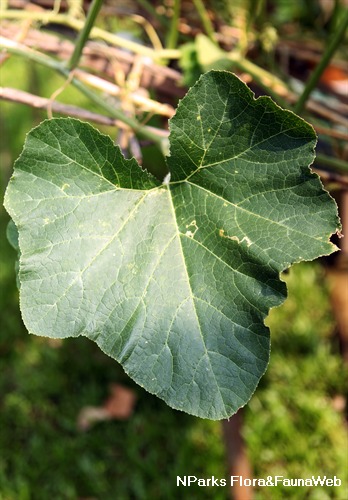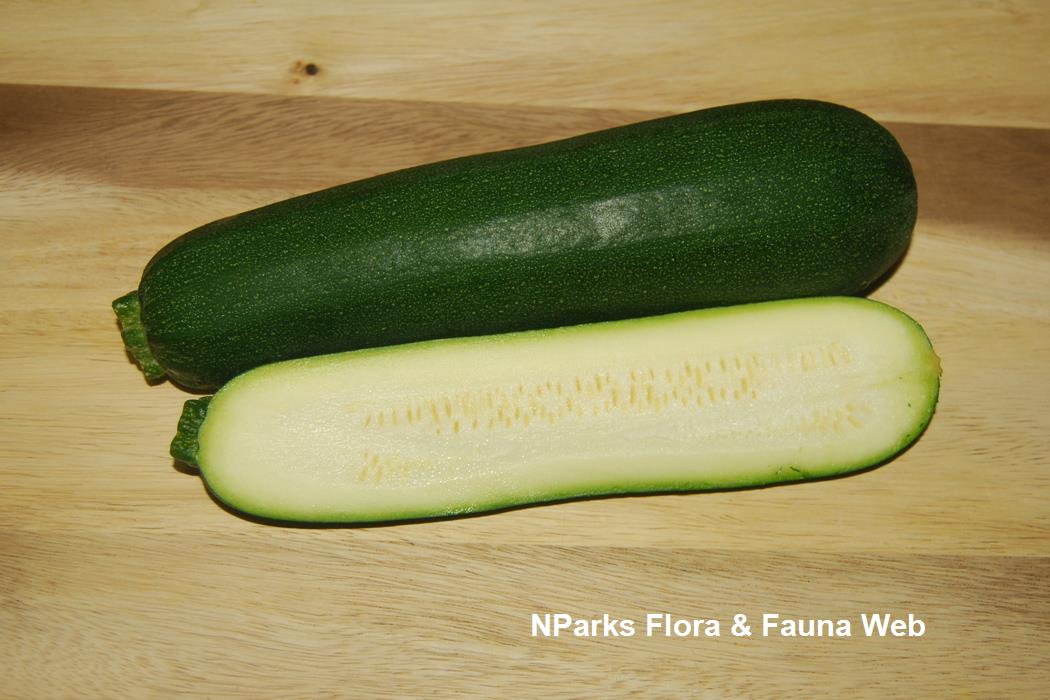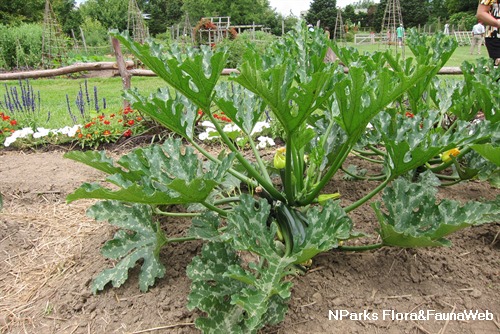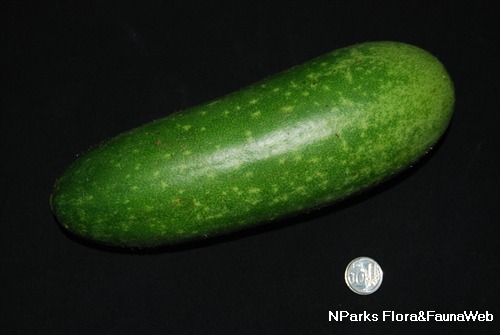
Back
Cucurbita moschata Duchesne
| Family Name: | Cucurbitaceae |
| Synonyms: | Cucurbita pepo var. moschata |
| Common Name: | Pumpkin, 南瓜 |
The Pumpkin (Cucurbita moschata) in popular in both Western and Eastern communities. In Asian countries, the leaves and fruit including the seeds are eaten in stews and stir-fries. In America, carving pumpkins into Jack-o’-lanterns during autumn is practised, it is often regarded as a symbol of Halloween. This tradition likely originated from the Irish folktale of “Stingy Jack” and was brought to the shores of the New World through immigrants.
Name
Classifications and Characteristics
| Plant Division | Angiosperms (Flowering Seed Plants) (Dicotyledon) |
|---|---|
| Plant Growth Form | Climber, Creeper |
| Lifespan (in Singapore) | Perennial |
| Mode of Nutrition | Autotrophic |
Biogeography
| Native Distribution | Tropical Asia, South America, North America |
|---|---|
| Native Habitat | Terrestrial |
| Local Conservation Status | Non-native |
Description and Ethnobotany
| Growth Form | Herbaceous climbing or creeping vine. |
|---|---|
| Foliage | The leaves are egg- to heart-shaped or approximately round with 3-5 egg-shaped or triangular lobes (25-30 cm long, 20-25 cm wide). The leaf stalk is 30 cm long or more. |
| Stems | The stems are hard and 5-angled with grooves and are covered with white hairs. |
| Flowers | Both female and male flowers are yellow, solitary, and bell- to saucer-shaped with 5 egg-shaped lobes. Compared to female flowers, the male flower is borne on a longer floral stalk (16-18 cm vs. 3-8 cm), the sepals are less leaf-like, and they are about the same size or larger (5-13.5 cm long vs. <7.5 cm long). |
| Fruit | The fruit is a pepo with a hard and 5-angled, grooved fruit stalk, enlarged where it is attached to the fruit. The fruit is variable in shape size and colour. Each fruit contains large numbers of yellowish-white seeds which are egg-shaped to elliptical with a thickened margin. |
| Cultivation | It is best grown under full sun, in well-drained and fertile growing medium in neutral to slightly acidic conditions. It does not do well in waterlogged conditions. Seeds may take 5 to 7 days to germinate. The gourds will be ready to harvest 90 to 120 days after sowing seed depending on the varieties. Grow the plant in a sunny location with a support or trellis and install a hammock-like structure to hold the fruit as it develops. |
| Etymology | The genus Cucurbita means gourd in Latin and the specific epithet moschata means musky. |
| Ethnobotanical Uses | Edible Plant Parts : Edible Fruits, Edible Leaves, Edible Flowers, Edible Stems, Edible Seeds Food (Fruit or Vegetable): The immature and mature fruit is eaten cooked as a vegetable and used in soups in South-East Asia. It is also used in desserts. The seeds can be cooked and eaten, oil can also be extracted from the seeds. |
Landscaping Features
| Landscape Uses | Parks & Gardens, Trellis / Arbour / Pergola |
|---|---|
| Thematic Landscaping | Economic Garden |
Fauna, Pollination and Dispersal
| Pollination Method(s) | Biotic (Fauna) (Insects (Bee)) |
|---|
Plant Care and Propagation
| Light Preference | Full Sun |
|---|---|
| Water Preference | Moderate Water |
| Plant Growth Rate | Very Fast |
| Rootzone Tolerance | Moist Soils, Well-Drained Soils, Fertile Loamy Soils |
| Propagation Method | Seed |
| Seed / Spore Germination Duration | 7 days |
Foliar
| Mature Foliage Colour(s) | Green |
|---|---|
| Mature Foliage Texture(s) | Velvety / Furry / Tomentose |
| Foliar Type | Simple / Unifoliate |
| Foliar Attachment to Stem | Petiolate |
| Foliar Shape(s) | Non-Palm Foliage |
| Foliar Venation | Palmate |
| Foliar Margin | Serrate / Toothed, Denticulate |
| Foliar Apex - Tip | Obtuse |
Floral (Angiosperm)
| Flower & Plant Sexuality | Unisexual Flowers , Monoecious |
| Flower Colour(s) | Yellow / Golden |
|---|
| Flower Texture(s) | Wrinkled |
| Flower Grouping | Solitary |
| Flower Location | Axillary |
| Flower Symmetry | Radial |
| Individual Flower Shape | Campaulate / Bell-shaped, Saucer-shaped |
Fruit, Seed and Spore
| Mature Fruit Colour(s) | Cream / Off-White, Green |
|---|---|
| Mature Fruit Texture(s) | Smooth, [Remarks] (Ribbed) |
| Fruit Classification | Simple Fruit |
| Fruit Type | |
| Mature Seed Texture(s) | Smooth |
| Seed Quantity Per Fruit | Numerous (>20) |
Image Repository
Others
| Master ID | 31803 |
|---|---|
| Species ID | 6203 |
| Flora Disclaimer | The information in this website has been compiled from reliable sources, such as reference works on medicinal plants. It is not a substitute for medical advice or treatment and NParks does not purport to provide any medical advice. Readers should always consult his/her physician before using or consuming a plant for medicinal purposes. |







